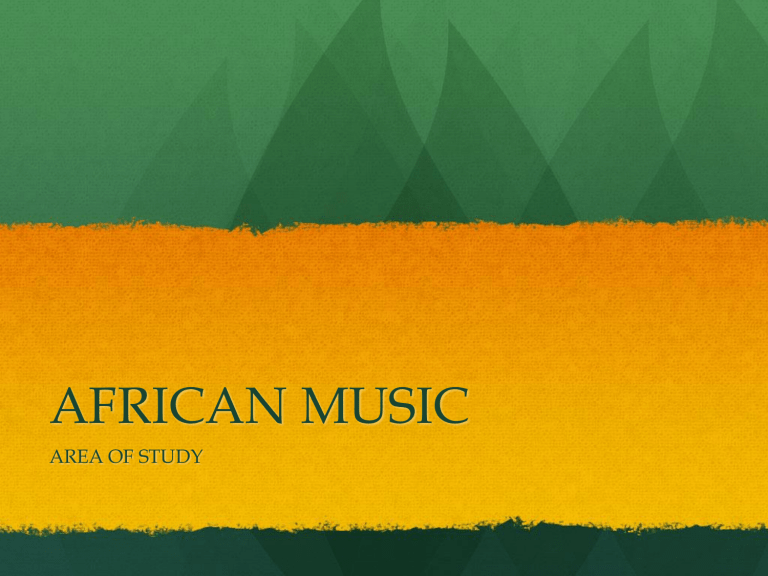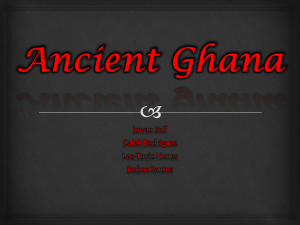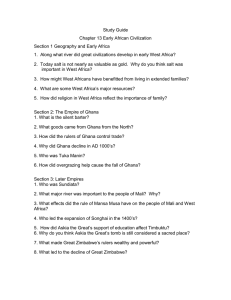AFRICANPPT

AFRICAN MUSIC
AREA OF STUDY
AFRICAN MUSIC
“Traditional African music is symbolic, an expression and validation of psychic energy.”
W. Komla Amoakua
CULTURE
In traditional Africa, music is an integral part of life and is linked with the worldview of the society in which it is produced. It has social, ritual, and ceremonial functions as well as some purely recreational purposes. Traditional art forms, including music, are rooted in mythology, legends, and folklore, and are associated with gods, ancestors and heroes. Musical activities are ritualized and intended to link the visible world with the invisible. Dancing is often an important part of the ritual and spiritual aspect of music.
PERCUSSION
Percussion instruments are the most popular instrument in African societies. Rattles, friction sticks, bells, clappers, and cymbals are popular.
Many groups also use the sansa and xylophones.
Numerous types of drums are also used. Various wind instruments are made out of tusks, horns, conch shells, wood or gourds. Styles of vocal music vary from area to area. This is due partly to the different languages spoken in different areas. Most
African languages are tonal languages which are reflected in the singing.
NOTATION
Traditional African music does not have a written tradition. This makes it difficult to notate the music using the Western staff. The pitches and subtle differences in intonation do not translate easily. The
Western scale patterns that relate most closely to
African music are tetratonic, pentatonic, hexatonic or heptatonic arrangements. Melodic patterns are affected by intonation patterns of the language. For example, tetratonic scales are usually associated with primitive music, not modern art music.
INSTRUMENTS
The main instrument in the Lobi area of Ghana is the xylophone, some of which are tuned to a tetratonic scale. In eastern Uganda, the Gwere use for their six-string harp (called tongoli) a tetratonic scale in which all the intervals are nearly equal, which to Western ears sounds like a chain of minor thirds .
RHYTHM
The rhythmic aspect of African music unites the music of various groups and areas. Rhythm is made of patterns; similar patterns are found throughout all of Africa. Harmonization is typically created through singing in thirds, fourths and fifths, parallel to the main melody.
MELODY
While drumming is very popular in Africa and is more important than melodic music in some societies, melodic music is important in others. The mbira is one of the most popular melodic instruments in Africa. Different cultures use the mbira in different ways. Also, the mbira exists in different forms in different cultures. Some mbira are used for entertainment and others for religious ceremonies. Often, the people who can own and play the mbira are restricted to chiefs or other important people, especially when it is being played for religious purposes.
FIND A PICTURE OF THE MBIRA…
GHANA
The Republic of Ghana; Boarded by the Ivory Coast on the West and the Gulf of Guinea to the South. Ghana means “Warrior King” derived from the ancient
Ghana Empire. Ghana is one of the largest cocoa producers in the world.
“POSTAL
WORKERS
CANCELLING
STAMPS IN
GHANA
UNIVERSITY
POST OFFICE
These men are working, not putting on a musical show; people pass by the work place paying little attention to the “music.” (I used to go often to watch and listen to them and they gave the impression that they thought I was somewhat odd for doing so.) The four men making the sounds you hear are workers canceling letters at the University of Ghana post office. Each letter must be canceled by hand, a boring task that these men make more palatable by setting the work to music. Twice a day the letters that must be canceled are laid out in two files, one on either side of a divided table. Two men sit across from one another at the table, and each has a hand-canceling machine (like the price markers you may have seen in supermarkets), an ink pad, and a stack of letters. The work part of the process is simple; a letter is slipped from the stack with the left hand, and the right hand inks the marker and stamps the letter - a repetitive task by anyone’s standard but one made for setting to music since it is rhythmic (or can be made so) and it produces audible sound.
This is what you are hearing; the two men seated at the table slap a letter rhythmically several times to bring it from the file to the position on the table where it is to be canceled (this act makes a lightsounding thud). The marker is inked one or more times (the lowest, most resonant sound you hear) and then stamped on the letter (the high-pitched mechanized sound you hear).







